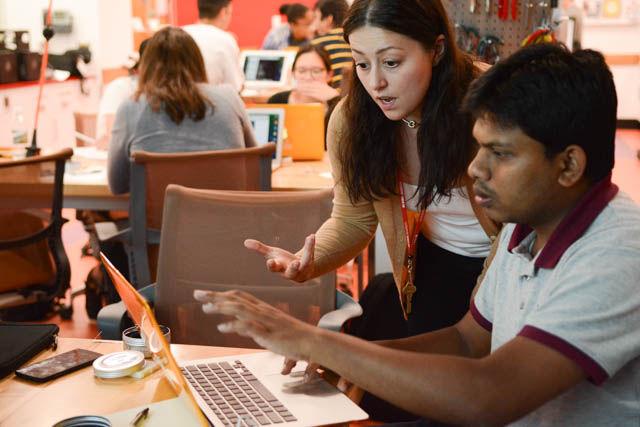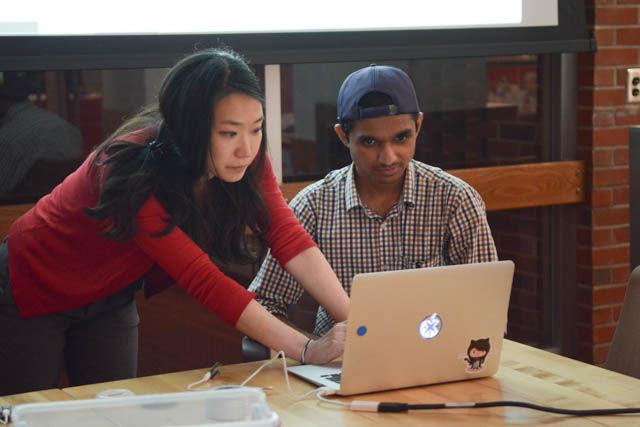Buzzfeed’s GE Internet of Things Fellow at the Open Lab for Journalism, Technology and the Arts, led an interactive workshop at the D.H. Hill Makerspace and spoke at the D.H. Hill Library auditorium Monday, teaching students about the Internet of Things (IoT). The program was part of NCSU Libraries’ Making Space initiative, a series of public talks and workshops geared toward women in STEM fields.
Christine Sunu, the event’s host, studied at Brown University and the Yale School of Medicine. She discussed the IoT’s future and her contributions to the field.
Sunu proposed that while the IoT can be perceived as a novelty — such as internet-connected doorbells, coffee machines and refrigerators — its future could include the connection of emotion and technology and new, more practical purposes.
Sunu displayed one of her Internet of Things projects: “Buddy,” a stuffed animal knit with conductive yarn and a “skin” that registers how it is handled. Buddy sends information to the Internet about how and when it was handled by recording the emotions of the person holding Buddy during different situations, like sleeping or watching movies. Buddy streams data to the internet through a cellular board located in its tail, and records data onto an SD card inside. Buddy will in turn reflect the narrative shared with the person by recording how and when it is petted, shaken and played with. The project intends to build an emotional narrative around an object of sentimental value.
In the IoT’s current state, companies sell proposals based on trying to sell the consumer something basic. This will change, however, when the market becomes more consumer-driven, according to Sunu. She draws to the example of what Twitter would be like in the age of AOL, when consumers did not drive the technology market like they do now.
“Consumers might make different things than companies with responsibilities,” Sunu said. “You wouldn’t make smart refrigerators, or a smart doorbell, you would just find another solution to a problem like that and move on. Maybe your problem is that you’re really worried because you live in a bad neighborhood, and you don’t know who’s outside your door, somebody could be stealing your packages. There’s a lot of other things that we can connect the Internet to solve something like that.”
The workshop at Makerspace explored broad issues and how the IoT could be applied in these areas. Students broke into groups to tackle different of the cultivation of vegetables as a resolve to world hunger, and to begin the design process for the application of Internet of Things technology.
Sunu explained the design process and how it operates through a rigorous research process involving interviewing many people, placing oneself in their positions and hearing all of their compiled solutions.
“The research process is so important, I cannot stress it enough,” Sunu said. “It is so much easier and better and more effective to design something when you understand the audience. It is actually impossible to do it otherwise.”
Students at the workshop designed an IoT product to satisfy a duty involved with different areas inherent to cultivating vegetables, such as local distribution, transportation and local growth.
After the activity, Sunu and the Making Space instructors Josephine McRobbie, the assistant director and chief of staff and Lauren Di Monte, an NCSU Libraries Fellow, led a coding activity to further delve into IoT technology.
“My favorite part of the workshop was the adding of a human aspect to IoT technology where you can actually help people with it, and you can really think through problems this way,” said Victoria Rind, a senior studying textile engineering who attended the workshop.
During the Making Space workshop on Monday, Sept. 19, Aditya Shirode, a second year graduate student studying computer science, receives help on using IFTTT, or If This, Then That, from Christine Sunu, workshop facilitator and GE Internet of Things Fellow at the Open Lab for Journalism, Technology, and the Arts at BuzzFeed. Participants learned about the connection between information technology and physical objects and had the chance to program a device with simple commands at the end of the workshop hosted at the Makerspace in D.H. Hill Library.









